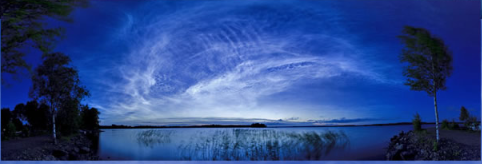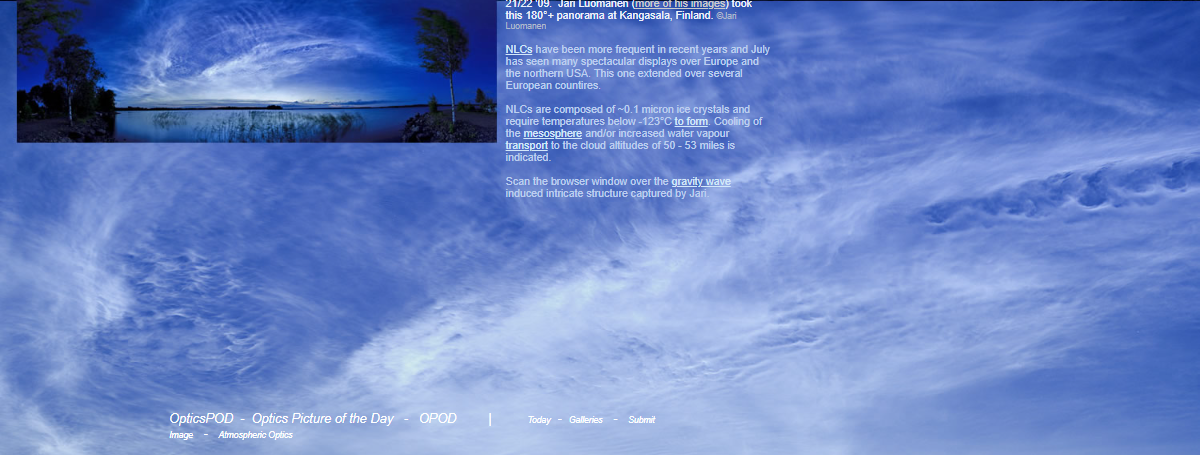NLCs continue!
NLCs Continue to Mesmerize: A Closer Look at Noctilucent Clouds
Noctilucent clouds (NLCs) have been captivating skywatchers around the world with their ethereal beauty. In recent years, these mesmerizing displays have become more frequent, treating observers to spectacular sightings during the month of July. This phenomenon has been particularly prominent over Europe and the northern regions of the United States, where NLCs have adorned the night sky with their intricate structures.
NLCs are composed of ice crystals measuring approximately 0.1 microns in size. These delicate formations require extremely low temperatures, typically below -123°C (-189.4°F), to take shape. The formation process involves the cooling of the mesosphere, a layer of Earth's atmosphere located roughly 50 to 53 miles above the surface, or an increase in water vapor transport to the altitudes where these clouds form.
One remarkable example of NLCs was captured by Jari Luomanen, an avid photographer, who shared a stunning 180°+ panorama taken in Kangasala, Finland. The image reveals the intricate structure of NLCs and provides a glimpse into the mesmerizing patterns created by gravity waves. These waves, induced by atmospheric disturbances, contribute to the unique appearance of these nocturnal clouds.
As we continue to witness an increase in NLC activity, scientists and sky enthusiasts alike are eager to unravel the mysteries surrounding these captivating formations. Here are some key points to consider when exploring the world of NLCs:
-
Formation: NLCs are formed when water vapor freezes onto tiny dust particles high in the atmosphere. The unique combination of low temperatures and increased water vapor transport allows for the creation of these mesmerizing clouds.
-
Mesosphere: NLCs reside in the mesosphere, one of Earth's atmospheric layers located above the stratosphere. This region is characterized by extremely low temperatures and sparse air molecules, providing an ideal environment for the formation of ice crystals.
-
Ice Crystal Size: The ice crystals comprising NLCs are exceptionally small, with an average size of 0.1 microns. This minuscule scale contributes to their striking appearance, as they scatter and reflect sunlight during twilight hours.
-
Gravity Waves: The intricate patterns seen within NLCs are often influenced by gravity waves. These waves are created by atmospheric disturbances, such as wind patterns or temperature fluctuations, and contribute to the unique structures observed in these clouds.
-
Geographical Distribution: While NLCs have been observed in various parts of the world, their occurrence is more frequent at higher latitudes, closer to the poles. This is due to the specific atmospheric conditions required for their formation.
-
Seasonal Variations: NLCs are predominantly visible during the summer months in the respective hemispheres. This seasonal variation is attributed to the increased availability of water vapor and the unique temperature conditions prevalent during this time of the year.
-
Scientific Significance: Studying NLCs provides valuable insights into the dynamics of Earth's upper atmosphere. By analyzing their formation, behavior, and changes over time, scientists can gain a deeper understanding of our planet's complex atmospheric processes.
-
Observing NLCs: To catch a glimpse of these captivating clouds, it is best to look towards the northern or southern horizon during the summer months. Ideal viewing conditions include clear skies and minimal light pollution.
-
Photography Tips: Capturing the beauty of NLCs can be a rewarding endeavor for photographers. Using long exposures and adjusting camera settings to capture low-light conditions can help bring out the intricate details and colors present in these noctilucent clouds.
-
Public Interest: The increasing popularity of NLC sightings has sparked public interest and enthusiasm for atmospheric optics. Social media platforms and online communities provide a space for individuals to share their experiences and photographs, fostering a sense of awe and curiosity surrounding these celestial phenomena.
Noctilucent clouds continue to enchant skywatchers with their ethereal beauty and intricate structures. As our understanding of these captivating formations grows, so does our appreciation for the wonders of our atmosphere. Whether you are a scientist, photographer, or simply an admirer of natural phenomena, NLCs offer a captivating glimpse into the mysteries of the night sky. So keep your eyes on the horizon and prepare to be mesmerized by the enchanting dance of Noctilucent clouds.


NLCs Continue! - Noctilucent cloud display July 21/22 '09. Jari Luomanen (more of his images) took this 180°+ panorama at Kangasala, Finland. ©Jari Luomanen
NLCs have been more frequent in recent years and July has seen many spectacular displays over Europe and the northern USA. This one extended over several European countires.
NLCs are composed of ~0.1 micron ice crystals and require temperatures below -123°C to form. Cooling of the mesosphere and/or increased water vapour transport to the cloud altitudes of 50 - 53 miles is indicated.
Scan the browser window over the gravity wave induced intricate structure captured by Jari.

Note: this article has been automatically converted from the old site and may not appear as intended. You can find the original article here.
Reference Atmospheric Optics
If you use any of the definitions, information, or data presented on Atmospheric Optics, please copy the link or reference below to properly credit us as the reference source. Thank you!
-
<a href="https://atoptics.co.uk/blog/nlcs-continue/">NLCs continue!</a>
-
"NLCs continue!". Atmospheric Optics. Accessed on April 19, 2024. https://atoptics.co.uk/blog/nlcs-continue/.
-
"NLCs continue!". Atmospheric Optics, https://atoptics.co.uk/blog/nlcs-continue/. Accessed 19 April, 2024
-
NLCs continue!. Atmospheric Optics. Retrieved from https://atoptics.co.uk/blog/nlcs-continue/.